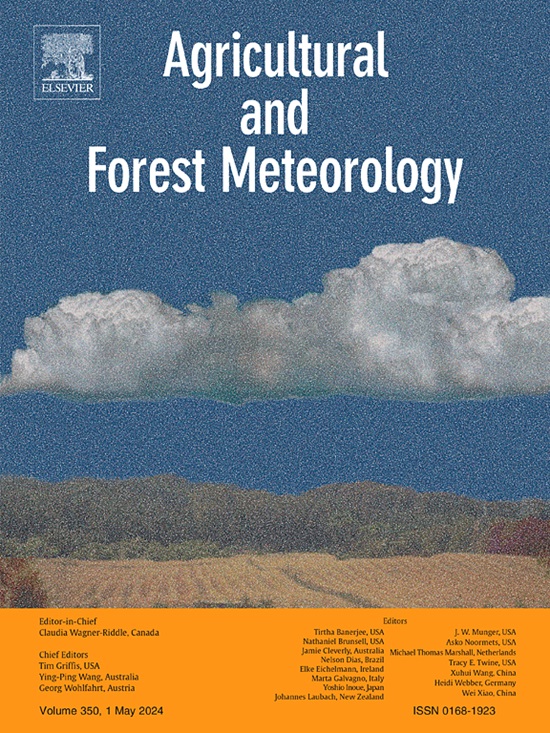积雪深度和春季温度控制着青藏高原春季物候变化和生长季节动态
IF 5.6
1区 农林科学
Q1 AGRONOMY
引用次数: 0
摘要
为了探索青藏高原近四十年来植被物候时空变异及其在快速气候变化下的驱动因素,利用基于GIMMS NDVI和MODIS NDVI的像素级单变量线性回归模型,构建了青藏高原1982-2020年的月度归一化植被指数(NDVI)数据集。扩展的 NDVI 数据集通过了一致性检验(R2 = 0.99,P < 0.001)。在此基础上,根据物候观测数据确定了检索植被物候的最佳阈值。利用滞后相关分析和结构方程模型分析了气候变化对植被物候影响途径的空间差异。根据扩展数据集,生长季开始(SOS)和生长季结束(EOS)的最佳阈值分别为 0.30 和 0.80。SOS 对雪深的反应滞后三个月,对温度的反应滞后一个月。SOS 的变化主要受中西部热量区积雪深度的负效应和东南部热量区春季温度的负效应的影响,而 EOS 的变化主要受中西部热量区秋季温度的正效应和东南部热量区 SOS 的正效应的影响。此外,物候变化在应对气候变化时表现出海拔依赖性,高海拔地区积雪深度的减少比低海拔地区更能延迟 SOS 的出现。这可归因于海拔变暖,即海拔越高,积雪深度减少得越快。因此,在未来气候变暖的情况下,大洋洲高海拔地区的高山生态系统可能会对积雪覆盖的变化特别敏感。本文章由计算机程序翻译,如有差异,请以英文原文为准。
Snow depth and spring temperature dominate the spring phenological shifts and control growing season dynamics on the Tibetan Plateau
To explore the spatio-temporal variability of vegetation phenology and its drivers under rapid climate change on the Tibetan Plateau (TP) over the past four decades, a monthly normalized vegetation index (NDVI) dataset was constructed for the TP from 1982 to 2020 using pixel-level univariate linear regression models based on GIMMS NDVI and MODIS NDVI. The extended NDVI dataset passed a consistency check (R2 = 0.99, P < 0.001). From here, the optimal thresholds for retrieving vegetation phenology were determined based on phenological observation data. Spatial differences among the pathways of influence of how climate change affected vegetation phenology were analyzed using lagging correlation analysis and structural equation modeling. Based on the extended dataset, the optimal thresholds for the start of the growing season (SOS) and the end of growing season (EOS) were 0.30 and 0.80, respectively. The SOS had a three-month lag in response to snow depth and a one-month lag in response to temperature. The variation in SOS was mainly influenced by a negative effect of snow depth in the central-western TP and a negative effect of spring temperatures in the south-eastern TP, while the variation in EOS was mainly influenced by a positive effect of fall temperature in the central-western TP and a positive effect of SOS in the south-eastern TP. Additionally, phenological changes displayed altitude dependence in response to climate change, with the reduction in snow depth delaying the SOS more at higher altitudes than at lower altitudes. This can be attributed to elevation-dependent warming, where snow depth is reduced more quickly at higher altitudes. Thus, alpine ecosystems at higher elevations on the TP may be particularly sensitive to snow cover changes under future warming scenarios.
求助全文
通过发布文献求助,成功后即可免费获取论文全文。
去求助
来源期刊
CiteScore
10.30
自引率
9.70%
发文量
415
审稿时长
69 days
期刊介绍:
Agricultural and Forest Meteorology is an international journal for the publication of original articles and reviews on the inter-relationship between meteorology, agriculture, forestry, and natural ecosystems. Emphasis is on basic and applied scientific research relevant to practical problems in the field of plant and soil sciences, ecology and biogeochemistry as affected by weather as well as climate variability and change. Theoretical models should be tested against experimental data. Articles must appeal to an international audience. Special issues devoted to single topics are also published.
Typical topics include canopy micrometeorology (e.g. canopy radiation transfer, turbulence near the ground, evapotranspiration, energy balance, fluxes of trace gases), micrometeorological instrumentation (e.g., sensors for trace gases, flux measurement instruments, radiation measurement techniques), aerobiology (e.g. the dispersion of pollen, spores, insects and pesticides), biometeorology (e.g. the effect of weather and climate on plant distribution, crop yield, water-use efficiency, and plant phenology), forest-fire/weather interactions, and feedbacks from vegetation to weather and the climate system.

 求助内容:
求助内容: 应助结果提醒方式:
应助结果提醒方式:


